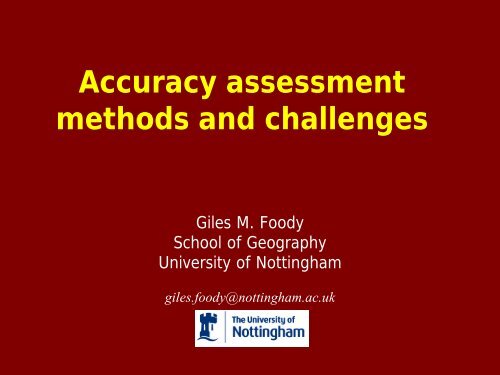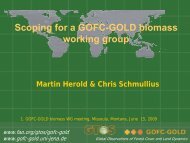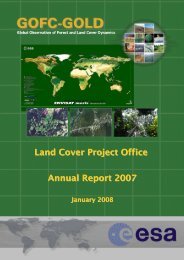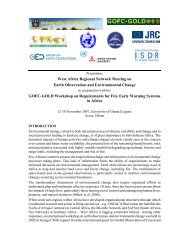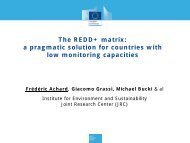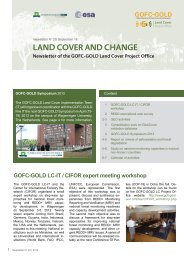Accuracy assessment methods and current challenges
Accuracy assessment methods and current challenges
Accuracy assessment methods and current challenges
Create successful ePaper yourself
Turn your PDF publications into a flip-book with our unique Google optimized e-Paper software.
<strong>Accuracy</strong> <strong>assessment</strong><br />
<strong>methods</strong> <strong>and</strong> <strong>challenges</strong><br />
Giles M. Foody<br />
School of Geography<br />
University of Nottingham<br />
giles.foody@nottingham.ac.uk
Background<br />
Need for accuracy <strong>assessment</strong> established.<br />
Considerable progress – now see use of<br />
probability sampling, provision of confidence<br />
intervals/SE etc.<br />
BUT, <strong>challenges</strong> remain as major errors, biases<br />
<strong>and</strong> uncertainties remain.
Challenges include<br />
• Class definition (what is a forest)<br />
• Definition of change – modification v conversion etc.<br />
• Impacts of spatial mis-registration<br />
• Inter-senor radiometric calibration<br />
• Variations in sensor properties (spatial resolution etc)<br />
• Impacts of time of image acquisition<br />
• Required precision of estimation<br />
• Rarity <strong>and</strong> sampling issues<br />
etc. etc.<br />
Here focus on 2 issues connected with the ground<br />
reference data – ‘quality <strong>and</strong> size’
PART 1: Error matrix Interpretation<br />
Commonly evaluate accuracy with basic binary<br />
confusion matrix
Popular measures e.g.<br />
Sensitivity = Producer’s accuracy =<br />
TP<br />
TP + FN<br />
Prevalence =<br />
TP + FN<br />
TP + FN + FP + TN<br />
Others (e.g. user’s accuracy) may be derived.
A simple question<br />
How accurate is this classification (or estimates of<br />
change)<br />
Is the producer’s accuracy = 160/260 61% <br />
Is amount of change = 260/1000 26%
NO, because the matrix might look like<br />
but is actually:
Occurs because ground data set is imperfect:<br />
Good news - can correct for ground data error.<br />
Note - here assumed conditional independence (trends more<br />
complex <strong>and</strong> can be in different direction if invalid <strong>and</strong> will<br />
be invalid in many studies).
Impact on estimation<br />
Real accuracy (%) Perceived<br />
Ground data Remote sensing RS accuracy Prevalence<br />
90 80 61 26<br />
95 90 76 23<br />
Systematically underestimate accuracy of remote sensing<br />
change detection <strong>and</strong> overestimate amount of change.
Impact of imperfect ground data<br />
Systematic bias.<br />
e.g.<br />
- Underestimate producer’s accuracy.<br />
- Typically overestimate prevalence (e.g. amount of<br />
change).<br />
Magnitude of bias can be very large for even if<br />
ground data set is highly accurate.<br />
Can correct/compensate for ground data error.
PART 2: Comparisons<br />
Often compare (e.g. accuracy over time, change<br />
rates between regions). Based on comparison of<br />
proportions.<br />
Must design an accuracy <strong>assessment</strong> programme<br />
to meet its objectives.<br />
One key concern is the<br />
of the testing set.<br />
Too large – any non-zero difference will<br />
appear statistically significant.<br />
Too small – programme may fail to detect an important<br />
difference.
Sample size determination<br />
Often based on precision to estimate proportion<br />
p ± h = p ± z α/2 (SE)<br />
p (1 − p)<br />
SE =<br />
n<br />
2<br />
z<br />
/ 2P(1<br />
− P)<br />
n = α 2<br />
h
BUT<br />
Aim is often not to estimate accuracy to a given<br />
precision but to use in a comparative analysis<br />
- comparison against a target<br />
- comparison against another accuracy<br />
(e.g. classifier comparison)<br />
….need to consider additional properties.
Comparison<br />
Very common v. target e.g.<br />
or classifier evaluation e.g.<br />
z<br />
=<br />
ˆ κ − ˆ κ<br />
ˆ<br />
1<br />
2<br />
2 2<br />
σ κ<br />
+ σ κ<br />
1<br />
ˆ<br />
2<br />
BUT<br />
often inappropriate &<br />
pessimistically biased
Comparative analysis<br />
Comparative analyses often based on hypothesis<br />
testing.<br />
e.g. H o – no difference in accuracy<br />
H 1 – the accuracy values differ<br />
Two types of error:<br />
Type I – when H 1 is incorrectly accepted (declare a<br />
difference as being significant when it is not).<br />
Type II – when H o is incorrectly accepted (fail to<br />
detect a meaningful difference that does exist).
Type I error<br />
H 1 is incorrectly accepted (declare a difference as<br />
being significant when it is not).<br />
Probability of making a Type I error is expressed<br />
as the significance level, α<br />
Commonly set α = 0.05<br />
(i.e. a 5% chance of inferring a significant<br />
difference exists when actually is no difference)
Type II error<br />
H o is incorrectly accepted (fail to detect a meaningful<br />
difference that does exist).<br />
Probability of making a Type II error is β <strong>and</strong> related<br />
to the power of the test (1- β).<br />
Type I errors typically viewed x4 more important<br />
than Type II, so commonly, β = 0.2<br />
or (1- β) = 0.8
If (1- β) = 0.8 – 80% chance of declaring a<br />
difference that exists as being significant.<br />
Is 0.8 adequate <br />
Many studies often fail to detect a significant<br />
difference – did the study have sufficient power<br />
Tests using small sample sizes often underpowered.<br />
Difficult to interpret non-significant results (is there<br />
really no difference or just failed to identify it)
Estimating sample size<br />
To determine sample size need to consider:<br />
• Significance level α<br />
• Power (1- β)<br />
• Effect size – minimum meaningful difference.
e.g. common remote sensing scenario v target<br />
n′<br />
=<br />
⎡ z<br />
⎢<br />
⎢⎣<br />
α<br />
P<br />
− P<br />
0<br />
(1<br />
0)<br />
β 1(1<br />
1)<br />
1<br />
+ z<br />
P − P<br />
0<br />
P<br />
− P<br />
⎤<br />
⎥<br />
⎥⎦<br />
2<br />
<strong>and</strong> with continuity correction:<br />
n<br />
=<br />
n′<br />
⎛<br />
⎜1+<br />
⎜<br />
⎝<br />
1+<br />
2<br />
4 ⎟ ⎟ n P1<br />
− P0<br />
⎠<br />
′<br />
⎞<br />
2<br />
Use acquired data to test for difference using:<br />
z<br />
=<br />
p<br />
−<br />
P<br />
P Q<br />
o<br />
o<br />
o<br />
−<br />
1<br />
2n<br />
/ n
e.g. common scenario v another accuracy<br />
n′<br />
=<br />
( z<br />
+<br />
2<br />
α / 2<br />
2PQ<br />
z<br />
β<br />
P1<br />
Q1<br />
P2<br />
Q2<br />
)<br />
( P − P ) 2<br />
2<br />
1<br />
+<br />
<strong>and</strong> with continuity correction:<br />
n<br />
=<br />
n′<br />
⎛<br />
⎜1+<br />
1+<br />
4<br />
n′<br />
p<br />
p<br />
4 ⎟ ⎝<br />
2<br />
−<br />
1 ⎠<br />
⎞<br />
2<br />
Use acquired data to test for difference using:<br />
z<br />
=<br />
P<br />
1<br />
− P<br />
2<br />
−<br />
1<br />
2<br />
(<br />
1<br />
n<br />
+<br />
⎛ 1<br />
p(1<br />
− p)<br />
⎜ +<br />
⎝ n1<br />
1<br />
1<br />
n<br />
2<br />
1<br />
n<br />
2<br />
)<br />
⎞<br />
⎟<br />
⎠
Note:<br />
1. Equations may be re-written<br />
e.g.<br />
z<br />
β<br />
=<br />
P<br />
2<br />
− P1<br />
n − − zα<br />
/ 2<br />
2<br />
P2<br />
− P1<br />
PQ<br />
1<br />
1<br />
2<br />
+<br />
P Q<br />
2<br />
2<br />
PQ<br />
2. Can also use alternatives for related samples<br />
(e.g. McNemar test).<br />
3. Instead of hypothesis testing could use<br />
confidence intervals.
So what<br />
Remember, important to use appropriate size<br />
Too large – any non-zero difference<br />
will appear statistically significant.<br />
Too small – fail to detect an important difference.<br />
Sizes used in remote sensing….<br />
- range from 10s…100s…1000s…10,000+
Size needed:<br />
v target
v another accuracy
Conclusions<br />
Error in ground ‘truth’ can lead to systematic bias<br />
– underestimates accuracy <strong>and</strong> is correctable.<br />
<strong>Accuracy</strong> <strong>assessment</strong> often has a comparative<br />
component – has implications for sample size<br />
(need to specify effect size, α, <strong>and</strong> β).<br />
Required size may be quite large. Need to be<br />
aware of danger of using inappropriate size (too<br />
small or too large).<br />
☺ The end


